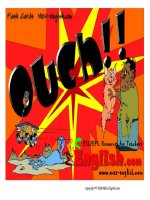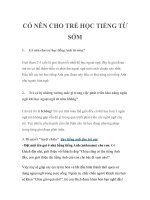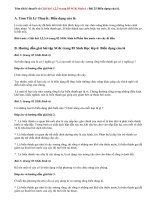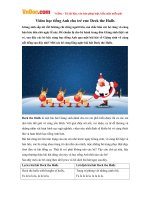Ecosystems lessons 1 2 23 trang
Bạn đang xem bản rút gọn của tài liệu. Xem và tải ngay bản đầy đủ của tài liệu tại đây (12.19 MB, 23 trang )
Ecosystems
Lessons 1–2
Grade 6
CA Unit 5
w w w.harcour tschool.com
ISBN-13: 978-0-15-349210-5
ISBN-10: 0-15-349210-4
Ë|xHSKBPDy492105zv*:+:!:+:!
CXECA08ARD605_LLR_CVa.indd 2-3
>
2/21/06 9:34:36 AM
Think About the Reading
1. What can you do to help you remember what you have
learned?
2. What questions do you have after reading this book?
How can you find the answers to your questions?
Copyright © by Harcourt, Inc.
All rights reserved. No part of this publication may be reproduced or transmitted in
any form or by any means, electronic or mechanical, including photocopy, recording,
or any information storage and retrieval system, without permission in writing from the
publisher.
Requests for permission to make copies of any part of the work should be addressed to
School Permissions and Copyrights, Harcourt, Inc., 6277 Sea Harbor Drive, Orlando,
Florida 32887-6777. Fax: 407-345-2418.
Hands-On Activity
1. Study an ecocsystem in your neighborhood. What kinds
of plants and animals live there? Can you figure out the
food chain or food webs that exist?
2. Make a list of plants and animals that you consume.
HARCOURT and the Harcourt Logo are trademarks of Harcourt, Inc., registered in the
United States of America and/or other jurisdictions.
Printed in the United States of America
ISBN-13: 978-0-15-349210-5
ISBN-10: 0-15-349210-4
1 2 3 4 5 6 7 8 9 10
179
15 14 13 12 11 10 09 08 07 06
School-Home Connection
If you have received these materials as examination copies free of charge, Harcourt
School Publishers retains title to the materials and they may not be resold. Resale of
examination copies is strictly prohibited and is illegal.
Research an energy pyramid. Try to find a pyramid of an
ecosystem that you know very little about. Study a desert,
underwater, or rainforest ecosystem. Examine food chains and
food webs. Use library books and the internet for information.
Possession of this publication in print format does not entitle users to convert this
publication, or any portion of it, into electronic format.
CXECA08ARD605_LLR_CVa.indd 4-5
2/21/06 9:34:45 AM
Ecosystems
Lessons 1–2
Lesson 1
What is an Ecosystem? . . . . . . . . . . . . . . . . . . . . . .2
Lesson 2
How Do Organisms Get Energy? . . . . . . . . . . . . .12
Visit The Learning Site!
www.harcourtschool.com
CXECA08ARD6051-2_BLR.indd 1
2/23/06 1:45:53 PM
1
VOCABULARY
ecosystem
population
community
habitat
niche
diversity
What
Is an
Ecosystem?
This ecosystem includes water,
grass, flowers and air.
All of these butterflies are
a population that shares
resources.
2
CXECA08ARD6051-2_BLR.indd 2
2/20/06 3:37:15 PM
The zebras and elephants are
from separate populations. But
they are a community that live
together.
An important part of the tortoise’s
habitat is its burrow.
The blue bird has its own niche in
an ecosystem.
The shells show the diversity of
the ecosystem they came from.
3
CXECA08ARD6051-2_BLR.indd 3
2/20/06 3:37:15 PM
READING FOCUS SKILL
MAIN IDEA AND DETAILS
The main idea is what the text is mostly about. Details are
pieces of information about the main idea.
Look for examples of what an ecosystem is.
Look for details as to how organisms interact in ecosystems.
Ecosystems
Each organism interacts with other organisms in an ecosystem.
An ecosystem is an area where organisms interact with one
another and with nonliving parts of the environment. An ecosystem
can be as large as a lake or as small as a puddle.
A Forest Ecosystem
Deer eat lower
branches of the
trees, allowing
more light to
reach the forest
floor.
Wood beetles
bore into trees
and tree trunks
to break them
down.
Trillium grows in
shady areas of
the forest floor.
Ants gather the
seeds and spread
the plant.
A new plant
begins to cover
the forest floor.
4
CXECA08ARD6051-2_BLR.indd 4
2/20/06 3:37:16 PM
An ecosystem has biotic parts, the living plants and animals. An
ecosystem also includes abiotic or nonliving parts, such as water,
soil, or climate.
The living parts of the ecosystem help shape the environment.
Plants root and grow and animals break down soil. Animals also
interact with one another. Larger animals eat plants and other
animals to survive.
The abiotic parts determine what lives in an eceosystem. Climate
is important. Organisms have features that make it possible for them
to live in certain ecosystems. Their needs for food, shelter, and water
are met only in certain areas.
What is the difference between biotic and abiotic parts
of an ecosystem?
Skunks roam
the forest at
night looking
for insects and
rodents to eat.
Wild blueberries
provide food for
animals in the
forest.
Cardinals eat
seeds, fruit, and
other insects.
5
CXECA08ARD6051-2_BLR.indd 5
2/20/06 3:37:31 PM
Active Ecosystems
Healthy ecosystems are active. Most of the activity begins in the
soil under your feet. The soil is a mixture of biotic and aboitic parts.
Rock is broken into small pieces. Air, water, and matter that contains
carbon is mixed int with the rock pieces. This soil supports plant life.
Many organisms in an ecosystem need healthy plant life for their
energy source.
The picture below shows earthworms and fungus. Both of these
living things help form soil that is rich with nutrients.
Fungus
Active ecosystems transfer
energy between organisms.
Earth Worms
6
CXECA08ARD6051-2_BLR.indd 6
2/20/06 3:37:43 PM
Kelp
Kelp forest animal
A marine (water) ecosystem is
active. The kelp forest gets its
energy from the sun.
There are different types of soils depending on the type of
ecosystem. Mojave Desert soil has many large rock particles and
very little decayed plant matter.
A water ecosystem does not have soil. The activity there is in the
water. Sunlight and nutrients give the biotic parts of the ecosystem
the materials needed for life.
Each ecosystem is always changing. An active ecosystem is always
exchanging energy. as living things grow and decay.
Name a biotic organism that enriches the soil.
7
CXECA08ARD6051-2_BLR.indd 7
2/20/06 3:37:54 PM
A Place to Live
When you observe an ecosystem, you
see different types of plants and animals.
In the forest, you may see trees, birds,
and bees. These are called populations.
A population is a group of organisms
of the same species living together in an
ecosystem.
All of the populations living in an
ecosystem make up a community. The
populations in a community interact,
using one another provide food
and shelter. Populations change the
environment in ways that benefit the
whole community.
How are a population and
a community related in an
ecosystem?
A coyote eat other animals, plants,
cactus fruits and beans.
Tortoises look for food in the
morning and use the cactus for
shade during the day.
Roadrunners store body heat for
cold desert nights.
Tarantulas come out of their burrows
at night to look for insects and small
rodents.
8
CXECA08ARD6051-2_BLR.indd 8
Gila monsters are lizards that can
live underground for months without
eating.
2/20/06 3:38:04 PM
We live in towns that have many
families. The same is true for organisms in
an ecosystem. Each has a certain habitat.
An organism’s habitat is the part of the
ecosystem in which it lives. The habitat
has everything the orgamism needs to
survive.
Each organism in an ecosystem has
a role. This is called the organism’s
niche. The niche includes everything the
organism needs to do so it can survive.
Finding shelter and food are part of the
niche.
A hawk and an owl can share the same
habitat because their niches are different.
A hawk hunts for food in the daytime and
the owl hunts at night. If two animals
had the exact same niche, they would
compete with one another for food,
shelter, and water. One might use these
resources better than the other and force
the one out of the habitat.
Why can’t animals share the
same niche?
9
CXECA08ARD6051-2_BLR.indd 9
2/20/06 3:38:15 PM
A coral reef is a very
diverse ecosystem.
Diversity
Organisms depend on diversity within an ecosystem. Diversity
is a measure of the number and the variety of the species in an
ecosystem. Some ecosystems are very diverse, while others have just
a few species.
Climate and location are two important factors. Usually,
ecosystems that are closer to the equator are more diverse. There
are more species in the hot, wet climate. Ecosystems closer to
Earth’s poles are less diverse and have fewer species. Fewer species
are adapted to living in such a cold climate. Adapted means that
they have features that make it possible for them to live there.
Ecosystems can become less diverse from human actions. When
people build many houses in one area or shopping centers, they
10
CXECA08ARD6051-2_BLR.indd 10
2/23/06 4:52:39 PM
can destroy ecosystems. They cut down forests and drain
swamps. Air and water pollution can also cause damage to habitats.
That reduces diversity in ecosystems.
What are factors that can determine an ecosystems
diversity?
Review
Complete this main idea sentence.
1. An ______ is an area in which organisms interact
with one another. Here, organisms also interact with
nonliving parts of the environment.
Complete each sentence with details about ecosystems.
2. A ______ is a group of organisms of the same speicies
living together.
3. A ______ is all of the populations living in an
ecosystem.
4. Every organism has a ______ in an ecosystem.
11
CXECA08ARD6051-2_BLR.indd 11
2/23/06 4:05:47 PM
2
VOCABULARY
producer
consumer
predator
prey
food chain
food web
How Do
Organisms
Get Energy?
A plant is a producer. It makes
its own food with help from the
sun.
A squirrel is a consumer because
it does not make its own food.
12
CXECA08ARD6051-2_BLR.indd 12
2/20/06 3:38:34 PM
A wolf is a predator because it
eats other animals.
The rabbit is prey for other
animals that eat it.
A food chain shows how
producers and consumers are
connected in an ecosystem.
A food web shows shows a group
of connected food chains in an
ecosystem.
13
CXECA08ARD6051-2_BLR.indd 13
2/20/06 3:38:36 PM
READING FOCUS SKILL
SEQUENCE
When you sequence things, you put them in order.
Look for the sequence of organisms in a food chain, from
producers to decomposers.
Producers and Consumers
Some organisms make their own food. They are called
producers. Plants are producers. Plants use energy from the sun
and carbon dioxide from the air. They use these and water from the
soil to make sugar and grow.
A consumer is an organism that eats other organisms. You are a
consumer. Animals are consumers. We all eat other living things.
Some animals eat only plants. Others are predators, they feed off
other living animals. The animals that predators eat are called prey.
What is the difference between a producer and a
consumer?
The California succulent
is a producer.
The California cougar
is a consumer.
14
CXECA08ARD6051-2_BLR.indd 14
2/20/06 3:38:41 PM
S
Getting Energy
All living things need energy to
move, eat, grow, and reproduce. A
food chain shows how organisms eat
and get energy in an ecosystem. A
food chain is a sequence that connects
producers and consumers.
The first step in the chain is when
a producer uses the sun to convert
energy to food. Then the energy is
passed to a consumer that eats the
producer. Now the consumer has some
of the plant’s energy. This consumer
may now be eaten by another
consumer. Energy is transferred. Last
in the food chain is a decomposer.
Decomposers break down the dead
plant and animal matter. They get
energy and also return nutrients to the
soil for plants to use.
In what part of a food chain
are producers?
Food Chain
This simple food chain shows the flow of
energy through several organisms in a
forest. The sun is the source of energy. The
strawberry plant is the producer. What are
the roles of the other three organisms?
15
CXECA08ARD6051-2_BLR.indd 15
2/23/06 1:46:37 PM
Food Webs
A food chain is a series of feeding relationships in an ecosystem.
Organisms are usually part of more than one food chain. A group of
connected food chains in an ecosystem is called a food web.
Most organisms eat more than one type of food. Because of
this, each food web contains several different food chains. In this
land food web, the mouse eats a strawberry plant and grass. The
owl eats the chipmunk and also the mouse. Bacteria and other
decomposers break down the remains of the strawberry plant,
chipmunk, and mouse.The nutrients return to the soil, where they
are used again by new plants.
B In this land food web, the owl and snake are the
highest-level consumers. What are the producers?
Land Food Web
Acorn
Owl
Strawberry Plant
Trees
Deer
Racoon
Grass
Chipmunk
Snake
Mouse
16
CXECA08ARD6051-2_BLR.indd 16
2/20/06 3:39:45 PM
A food web depends on producers. What would happen in the
aquatic food web if all the algae disappeared? The animals that eat
the algae would have less food and they could die out. Consumers
that eat only producers (such as algae) would have to look
somewhere else for food.
What is needed before energy can be produced in an
ecosystem?
Aquatic Food Web
B This aquatic food web shows organisms that live in water. It also shows
connections with organisms that live on land. What are the producers in
the ecosystem? What organisms are primary consumers?
Ducks
Great blue heron
Dragonfly
Raccoon
Frog
Duckweed
Algae
Turtle
Brown trout
Freshwater shrimp
Bluegill
CXECA08ARD6051-2_BLR.indd 17
17
2/20/06 3:39:55 PM
The Energy Pyramid
Energy is lost each time it passes from one organism to another.
Scientists found that 90 percent of an organism’s energy is gone
when it reaches the next step of the food chain.
An energy pyramid shows that energy is lost at each level of the
food chain. Because of this energy loss, the number of organisms
becomes fewer from one level to the next. This explains the
pyramid shape. There are fewer hawks in the pyramid than grape
plants, chipmunks, or snakes.
Hawk
0.1%
Snakes
1%
Chipmunks
10%
Grapes
100%
An Energy Pyramid
18
CXECA08ARD6051-2_BLR.indd 18
2/20/06 3:40:14 PM
Fewer organisms are at the higher levels of the pyramid. They are
getting the least amount of energy from what they consume.
Why is less energy available at each level of the
pyramid?
A wolf can be a consumer
and a predator
Review
Complete each sequence statement.
1. An organism that makes its own food is called
a ______ .
2. A ______ provides food for a ______ .
3. A ______ is animal that feeds on its ______ .
4. A ______ ______ is a sequence of connected producers
and consumers. A ______ ______ is a group of
connected food chains.
19
CXECA08ARD6051-2_BLR.indd 19
2/20/06 3:41:14 PM
GLOSSARY
community [kuh•MYOO•nuh•tee] All of the populations living in an
ecosystem.
consumer [kuhn•SOOM•er] An organism that eats other organisms.
diversity [duh•VER•suh•tee] A measure of the number and variety
of species in an ecosystem.
ecosystem [EE•koh•sis•tuhm] An area in which living things
interact with one another and with nonliving things.
food chain [FOOD CHAYN] A sequence of connected producers and
consumers.
food web [FOOD WEB] A group of connected food chains in an
ecosystem.
habitat [HAB•ih•tat] A place where people or animals live.
niche [NICH] An organism’s role in an ecosystem.
population [pahp•yoo•LAY•shuhn] A group of organisms of the
same species living together in an ecosystem.
predator [PRED•uh•ter] An animal that feeds on other living
animals.
prey [PRAY] An animal that a predator eats.
producer [ proh•DOOS•er] An organism that makes its own food.
20
CXECA08ARD6051-2_BLR.indd 20
2/20/06 3:41:20 PM
Think About the Reading
1. What can you do to help you remember what you have
learned?
2. What questions do you have after reading this book?
How can you find the answers to your questions?
Copyright © by Harcourt, Inc.
All rights reserved. No part of this publication may be reproduced or transmitted in
any form or by any means, electronic or mechanical, including photocopy, recording,
or any information storage and retrieval system, without permission in writing from the
publisher.
Requests for permission to make copies of any part of the work should be addressed to
School Permissions and Copyrights, Harcourt, Inc., 6277 Sea Harbor Drive, Orlando,
Florida 32887-6777. Fax: 407-345-2418.
Hands-On Activity
1. Study an ecocsystem in your neighborhood. What kinds
of plants and animals live there? Can you figure out the
food chain or food webs that exist?
2. Make a list of plants and animals that you consume.
HARCOURT and the Harcourt Logo are trademarks of Harcourt, Inc., registered in the
United States of America and/or other jurisdictions.
Printed in the United States of America
ISBN-13: 978-0-15-349210-5
ISBN-10: 0-15-349210-4
1 2 3 4 5 6 7 8 9 10
179
15 14 13 12 11 10 09 08 07 06
School-Home Connection
If you have received these materials as examination copies free of charge, Harcourt
School Publishers retains title to the materials and they may not be resold. Resale of
examination copies is strictly prohibited and is illegal.
Research an energy pyramid. Try to find a pyramid of an
ecosystem that you know very little about. Study a desert,
underwater, or rainforest ecosystem. Examine food chains and
food webs. Use library books and the internet for information.
Possession of this publication in print format does not entitle users to convert this
publication, or any portion of it, into electronic format.
CXECA08ARD605_LLR_CVa.indd 4-5
2/21/06 9:34:45 AM









